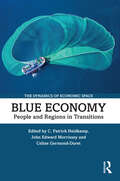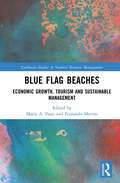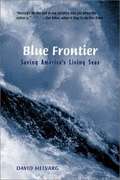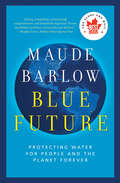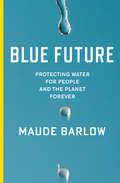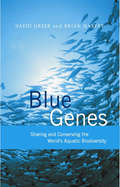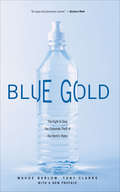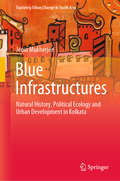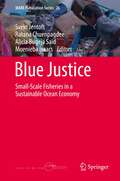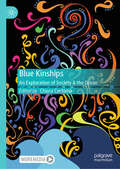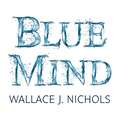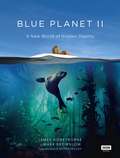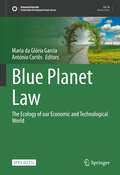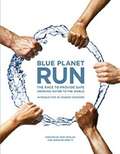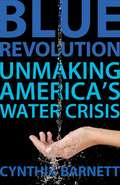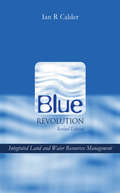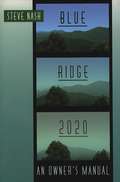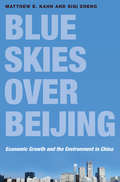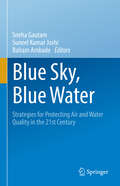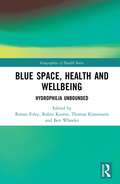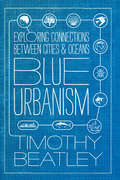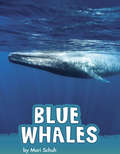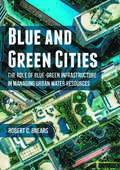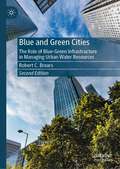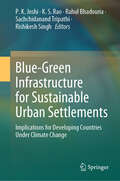- Table View
- List View
Blue Economy: People and Regions in Transitions (The Dynamics of Economic Space)
by C. Patrick Heidkamp John Edward Morrissey Celine Germond-DuretThis book presents state-of-the-art perspectives on the Blue Economy. It applies important geographical and sustainability transitions perspectives and underscores how Blue Economy dynamics are situated in regional contexts and shaped by the people who live there. The book highlights the Blue Economy concept as a potential driver of regionally sensitive, ecologically embedded, and community-focused sustainability. The scope for Blue Economy to form a core "cog" in our low-carbon future is obvious, from the potential for renewable energy production and coastal resilience building to possibilities for sustainable food production and the delivery of economic opportunities for peripheral communities. However, fundamental questions remain on how to meaningfully deliver these promises, such as how to avoid embedding a model of damaging extractivism, as per the terrestrial economy, and how to deliver on the key social sustainability principles of human well-being, equity, and justice when planning and developing blue economies. As the UN Decade of Ocean Science for Sustainable Development opens, this book provides a timely reminder of the richness, diversity, and potential of coastal and marine spaces. It advances geographical and transdisciplinary understandings of the Blue Economy and sets a baseline for continued scholarly engagement with the Blue Economy from a variety of perspectives. This timely contribution will be of interest to policy makers, academics, industry leaders, decision makers, and stakeholders working in or connected to the Blue Economy Sphere and working in the fields of Economic Geography, Regional Development, Public Policy and Planning, Environmental Studies, and Coastal Zone Management.
Blue Flag Beaches: Economic Growth, Tourism and Sustainable Management (Earthscan Studies in Natural Resource Management)
by María A. Prats Fernando MerinoThis book presents a comprehensive study of the role that the Blue Flag beach program has played around the world, considering economic, social and environmental perspectives. Since its creation in the 1980s, The Blue Flag program awards the management of beaches and marinas based on sustainability, services and quality of their management. To date there are currently close to five thousand awards around the world. Forty years on from the program's creation, this book provides a thorough evaluation of the program, to understand how it has evolved over time, the successes it has enjoyed and the challenges it has overcome, and may face in the future. As an international program, this book reflects the global nature of this program and actively discusses, examines and assesses the different realities and challenges faced by different countries around the world, drawing on case studies from across Europe, North America, Latin America, Africa and Asia. It examines the impact of the award on economic growth, from local to national, environmental protection and education, the development of sustainable tourism, and the sustainable management of beaches. The volume also contributes to emerging debates surrounding the certification of natural resources, where the Blue Flag program has been a pioneer in this field. This book will be of great interest to students and scholars of sustainable tourism, environmental economics, coastal and beach management, environmental conservation and sustainable development.
Blue Frontier: Saving America’s Living Seas
by David HelvargA fascinating account of America's oceans and ocean politics, Blue Frontier explores the impact of history, commerce and policy on marine life and by extension all life on earth. From the legacy of Navy-funded ocean research and development since World War II to the latest controversies surrounding beach closures, collapsing fish stocks, killer algae, hurricanes, and oil spills, Blue Frontier takes readers on an adventure-filled tour of America's last great wilderness range.
Blue Future: Protecting Water for People and the Planet Forever
by Maude BarlowSelected for The Globe 100 Books in 2013. The final book in Maude Barlow’s Blue trilogy, Blue Future is a powerful, penetrating, and timely look at the global water crisis — and what we can do to prevent it. The global water crisis has dramatically deepened. The stage is being set for drought on an unprecedented scale, mass starvation, and the migration of millions of refugees leaving parched lands in search of water. The story does not need to end in tragedy. In Blue Future, international bestselling author Maude Barlow offers solutions to the global water crisis based on four simple principles. Principle One: Water Is a Human Right chronicles the long fight to have the human right to water recognized and the powerful players still impeding this progress. Principle Two: Water Is a Common Heritage and Public Trust argues that water must not become a commodity to be bought and sold on the open market. Principle Three: Water Has Rights Too makes the case for the protection of source water and the need to make our human laws compatible with those of nature. Principle Four: Water Will Teach Us How to Live Together urges us to come together around a common threat — the end of water — and find a way to live more lightly on this planet. The final instalment in Barlow’s Blue trilogy, Blue Future includes inspiring stories of struggle and resistance from marginalized communities, as well as examples of government policies that work for people and the planet. A call to action to create a water-secure world, it is, in the end, a book of hope.
Blue Future: Protecting Water for People and the Planet Forever
by Maude BarlowWater is a human right: &“A rousing case for what will be one of the key environmental challenges of the twenty-first century.&” —Booklist The United Nations has recognized access to water as a basic human right—but there is still much work to be done to stem this growing environmental crisis. In this book, water activist Maude Barlow draws on her extensive experience to lay out a set of key principles that show the way forward to what she calls a &“water-secure and water-just world.&” Not only does she reveal the powerful players even now impeding the recognition of the human right to water, she argues that water must not become a commodity to be bought and sold on the open market. Focusing on solutions, she includes stories of struggle and resistance from marginalized communities, as well as government policies that work for both people and the planet. At a time when climate change has moved to the top of the national agenda and the stage is being set for unprecedented drought, mass starvation, and the migration of millions of refugees in search of water, Blue Future is an urgent call to preserve our most valuable resource for generations to come. &“In a book as clear as a pristine mountain stream, Maude Barlow lays out a practical and inspiring vision for how we can defend water—the source of all life—from the forces of death.&” —Naomi Klein, author of The Shock Doctrine
Blue Genes: Sharing and Conserving the World's Aquatic Biodiversity
by Brian HarveyThe advance of genetic sciences has led to a 'blue revolution' in the way we use aquatic biodiversity. By 2020, the world will be eating almost as much farmed as wild fish, marine bacteria could yield the cure for cancer and deep-sea bacteria may be exploited to gobble up oil spills. Science is moving ahead at a staggering speed, and the demand for genetic resources is growing rapidly - yet governance and policy lag far behind. This groundbreaking work is the first to look at the ownership, governance and trade in aquatic genetic resources. Blue Genes describes the growing demand for aquatic genetic resources and the desperate need to fill the policy vacuum about the management and conservation of aquatic biodiversity, which would help create a foundation for rules dictating access to, and use of, aquatic genetic resources. Special attention is paid to indigenous and local people having the right to access these resources and their role in managing and conserving aquatic biodiversity. The book concludes with policy recommendations specifically tailored to aquatic resources, with the use of six case studies from four continents to illustrate key issues.
Blue Gold: The Fight to Stop the Corporate Theft of the World's Water
by Maude Barlow Tony Clarke&“Probably the most eloquent call to arms we&’re likely to hear about the politics of water&” (The Globe and Mail, Toronto). In this &“chilling, in-depth examination of a rapidly emerging global crisis,&” Maude Barlow and Tony Clarke, two of the most active opponents to the privatization of water show how, contrary to received wisdom, water mainly flows uphill to the wealthy (In These Times). Our most basic resource may one day be limited: Our consumption doubles every twenty years—twice the rate of population increase. At the same time, increasingly transnational corporations are plotting to control the world&’s dwindling water supply. In England and France, where water has already been privatized, rates have soared, and water shortages have been severe. The major bottled-water producers—Perrier, Evian, Naya, and now Coca-Cola and PepsiCo—are part of one of the fastest-growing and least-regulated industries, buying up freshwater rights and drying up crucial supplies. A truly shocking exposé, Blue Gold shows in frightening detail why, as the vice president of the World Bank has pronounced, &“The wars of the next century will be about water.&” &“Maude Barlow and Tony Clarke combine visionary intellect with muckraking research and a concrete plan for action.&” —Naomi Klein, author of The Battle for Paradise &“A sobering, in-depth look at the growing scarcity of fresh water and the increasing privatization and corporate control of this nonrenewable resource.&” —Library Journal &“An angry and persuasive account.&” —Bloomberg Businessweek &“The dire scenarios laid out in this comprehensive book are truly frightening.&” —The San Diego Union-Tribune
Blue Infrastructures: Natural History, Political Ecology and Urban Development in Kolkata (Exploring Urban Change in South Asia)
by Jenia MukherjeeThis book focuses on Kolkata, formerly the colonial capital of and currently a major megacity in India, in terms of its extensive blue infrastructures, i.e., its rivers, canals and wetlands as an integrated composite whole. It unfolds ways in which this reclaimed urban space could determine, and in turn, could get determined by political fate, economic calculations and social livelihoods across changing political-economic imperatives and with large-scale implications on urban sustainability. Employing historical urban political ecology (HUPE) as the methodological framework by combining urban environmental history and urban political ecology, the book studies the changing urban environmental equations through several centuries, and its impact on the city and its people. Weaving the past, present and posterity of deltaic Kolkata, the book demonstrates that it is in these ‘blue infrastructures’ that the anecdote of origin, the account of functioning and the apprehension of survival of the city is rooted. By emphasizing the ecology ‘of’ cities instead of ecology ‘in’ cities approach, the book exposes the limitations of contemporary ecological restructuring efforts regarding Indian cities. Further, it offers a blueprint for future innovative and empirical research focusing on other major cities. Accordingly, this topical and original book will be of interest to students and researchers of environmental humanities, political ecology and urban studies.
Blue Justice: Small-Scale Fisheries in a Sustainable Ocean Economy (MARE Publication Series #26)
by Svein Jentoft Ratana Chuenpagdee Alicia Bugeja-Said Moenieba IsaacsFor small-scale fisheries around the world, the Blue Growth and Blue Economy initiatives may provide sustainable development, but only insofar as they align with the global consensus enshrined in the Voluntary Guidelines for Securing Sustainable Small-Scale Fisheries in the context of Food Security and Poverty Eradication. If states do nothing to fulfill the promises they made when they endorsed these guidelines in 2014, the Blue Economy will come at a loss for small-scale fisheries and further their marginalization in the ocean economy. Under the umbrella of Blue Justice, this book demonstrates that these risks are real and must be considered as states implement their sustainable ocean development plans. These are human rights issues, which are embedded into governance principles and institutions and which make a difference for small-scale fisheries people in their daily lives. In stressing the importance of policies and institutions that build on the experiences of small-scale fisheries people in the contexts in which they operate, this book draws on case studies of small-scale fisheries from countries on all continents to clarify what Blue Justice entails for small-scale fisheries and make suggestions for real change. “Through the Blue Justice paradigm, this book flags the relevance of recognizing the potential impact that different factors, including the Blue Economy approach, could bring to fishing communities, their livelihoods, cultural traditions, and other potential multidimensional conflicts. Vulnerability in fishing communities can increase and inequalities can be reinforced at different levels if individuals and community capabilities are not strengthened… A first of its kind, not to be missed, this book is informative, purposeful, and pertinent in an era of change”. Silvia Salas, CINVESTAV, Marine Resources Department, Mérida, Mexico "The studies reveal that Blue Justice is a ‘governability’ issue, which requires establishing ‘right’ institutions, that are transdisciplinary (integrated), participatory, and holistic. It is implicit from these writings that the SSF Guidelines and Blue Growth initiatives do not form two different discourses, and that the implementation of the former would resolve many of the justice issues caused by the latter, in favor of small-scale fisheries and their communities". Oscar Amarasinghe, Professor & Chancellor, Ocean University of Sri Lanka and President, Sri Lanka Forum for Small Scale Fisheries (SLFSSF)
Blue Kinships: An Exploration of Society & the Ocean
by Chiara CertomàBlue Kinship contributes to the emergent movement of ideas and practices that are interpreting the ocean as a conceptual and physical space for reconsidering our relationship with the complex, heterogeneous and mutable ecological systems of the Anthropocene; and, in consideration of the drastic and dramatic changes affecting the ocean&’s health, is working toward a paradigm change in consideration of the socio-cultural connection with the sea. Tightening the link between society and the ocean cannot be achieved by technological solutions alone, but requires a multidisciplinary understanding of the ocean's influence on the more-than-human society, and of society on the ocean. This book includes cross-cutting, theoretical analyses, methodological descriptions and case studies across the social and natural research that puts the ocean at the core of all global health to feed the emergent socio-cultural geography of the sea and marine social science perspectives.
Blue Mind: How Water Makes You Happier, More Connected and Better at What You Do
by Wallace J. NicholsWhy are we drawn to the ocean each summer? Why does being near water set our minds and bodies at ease? In Blue Mind, Wallace J. Nichols revolutionizes how we think about these questions, revealing the remarkable truth about the benefits of being in, on, under, or simply near water. Grounded in cutting-edge studies in neurobiology, cognitive psychology, economics, and medicine, and made real by stories of innovative scientists, doctors, athletes, artists, environmentalists, businesspeople and lovers of nature - stories that fascinate the mind and touch the heart - Blue Mind will awaken readers to the vital importance of water to the health and happiness of us all.
Blue Planet II
by James Honeyborne Mark BrownlowA lavish and definitive view of the oceanic world - accompanying the landmark 7-part BBC series narrated by Sir David Attenborough. With over 200 breath-taking photographs and stills from the BBC Natural History Unit's spectacular footage, this awe-inspiring study of life below the surface will amaze and enthral.'Jaw-dropping' - Variety'Substantial and awe-inspiring' - Publishers Weekly'Breath-taking' -- ***** Reader review'An incredible book and a must buy' -- ***** Reader review'Outstanding' -- ***** Reader review*************************************************************************Take a deep breath and dive into the mysteries of the ocean...Our understanding of ocean life has changed dramatically in the last decade, with new species, new behaviours, and new habitats being discovered at a rapid rate. Blue Planet II, which accompanies the epic BBC 7-part series, is a ground-breaking new look at the richness and variety of underwater life across our planet.From ambush hunters such as the carnivorous bobbit worm to cuttlefish mesmerising their prey with a pulsating light display, Blue Planet II reveals the never-before-seen secrets of the ocean.With over 200 breath-taking photographs and stills from the BBC Natural History Unit's spectacular footage, each chapter of Blue Planet II brings to life a different habitat of the oceanic world.As well as shining a light on ocean life, coral reef and arctic ice communities and shoreline existence, Blue Planet II examines unflinchingly what the future holds for our ocean dwellers. It's a book that will amaze, educate, captivate and astound.
Blue Planet Law: The Ecology of our Economic and Technological World (Sustainable Development Goals Series)
by Maria da Glória Garcia António CortêsBlue Planet Law is the global and future-oriented environmental law that is necessary to face the global environmental crisis in the Anthropocene, assuming especially the link between climate action (SDG 13) and ocean sustainability (SDG 14). This open access book focuses on means of overcoming global environmental problems such as climate change, ocean degradation and biodiversity loss and the consequent risks for human life, health, food and wellbeing. It explores how environmental law, at the international, European and national levels, might set economic and technological development on a more sustainable path. Law must engage in dialogue with other areas such as philosophy, economics, ecology, and biology. This book highlights protection of the climate and the oceans and sustainable use of natural resources, through new policies, economies and technologies, including biotechnology, with a view to the preservation of life, health, food and a healthy environment for the present and future generations. The book may be seen as a contribution to the UN Sustainable Development Goals 13 and 14 and a tribute to the Declaration of the United Nations Conference on the Human Environment, also known as the Stockholm Conference (1972), on its 50th Anniversary.
Blue Planet Run: The Race to Provide Safe Drinking Water to the World
by Jennifer Erwitt Rick SmolanFrom the creators of the highly acclaimed New York Times best-selling Day in the Life and America 24/7 series, Rick Smolan and Jennifer Erwitt, Blue Planet Run provides readers with a fascinating and thought-provoking look at the water problems facing humanity on every continent, as well as some of the hopeful solutions and courageous "water heroes" focused on alleviating this crisis. The large-format volume features provocative essays by Diane Ackerman (A Natural History of the Senses), environmental leaders Paul Hawken and Bill McKibben, journalists Michael Specter and Jeffrey Rothfeder, Emmy Award-winning TV broadcaster Mike Cerre, Michael Malone, of ABC News and inventor Dean Kamen (the Segway scooter). Advisors and staff include Phillip Moffitt, former editor and owner of Esquire magazine and Stephen Petranek, former editor-in-chief of Discover magazine. Blue Planet Run highlights the vital contributions of nonprofits around the world, including the groundbreaking work of the Blue Planet Run Foundation, which seeks to provide safe drinking water to 200 million people by 2027. The book includes coverage of the 2007 Blue Planet Run, an unprecedented, non-stop, around-the-world relay race designed as a wake-up call to the world. Twenty-one runners, representing 13 countries, began the race on June 1, 2007, at the United Nations and concluded in New York City on September 4, 2007, having circled the Earth in just 95 days while running over 15,000 miles across 16 countries in Europe, Asia and North America.
Blue Revolution
by Cynthia BarnettFrom backyard grottoes in California to sinkholes swallowing chunks of Florida, Blue Revolution exposes how the nation's green craze largely missed water-the No. 1 environmental concern of most Americans. But the book is big on inspiration, too. Blue Revolution combines investigative reporting with solutions from around the nation and the globe. Reporting from San Antonio to Singapore, long-time journalist Cynthia Barnett shows how local communities and entire nations have come together in a shared ethic to reduce consumption dramatically and live within their water means. The first book to call for a national water ethic, Blue Revolution is also a powerful meditation on water and community in America.
Blue Revolution: Integrated Land and Water Resources Management
by Ian Calder'Blue Revolution upturns some environmental applecarts - not for the hell of it, but so we can manage our environment better.' Fred Pearce, New Scientist This updated and revised edition of The Blue Revolution provides further evidence of the need to integrate land management decision-making into the process of integrated water resources management. It presents the key issues involved in finding the balance between the competing demands for land and water: for food and other forms of economic production, for sustaining livelihoods, and for conservation, amenity, recreation and the requirements of the environment. It also advocates the means and methodologies for addressing them. A new chapter, 'Policies, Power and Perversity,' describes the perverse outcomes that can result from present, often myth-based, land and water policies which do not consider these land and water interactions. New research and case studies involving ILWRM concepts are presented for the Panama Canal catchments and in relation to afforestation proposals for the UK Midlands.
Blue Ridge 2020
by Steve NashThe mountain chain known as the Blue Ridge traces a 550-mile arc through Pennsylvania, Virginia, North Carolina, Tennessee, South Carolina, and Georgia. Along the way, it encompasses Shenandoah National Park, Great Smoky Mountains National Park, the Blue Ridge Parkway, seven national forests, numerous federal wilderness areas and state parks, and parts of the Appalachian Trail. It is the largest concentration of public lands east of the Mississippi and home to an astonishing diversity of plant and animal life. But as the most extensive natural area in the increasingly populous Southeast, the Blue Ridge ecosystem faces unique challenges in the next decades. Drawing on scientific research in a variety of disciplines, journalist Steve Nash provides a clear and evenhanded introduction to some of the most hotly disputed environmental issues facing the Blue Ridge, including the invasion of exotic plants and insects, the explosive growth of suburban-style communities in natural areas, worsening air and water pollution, and the erratic management of national forests. Informative and highly readable, Blue Ridge 2020 takes a hard look at what is at risk in these mountains and what we--as the "owners" of the public lands--must do if we intend to preserve their future.
Blue Skies over Beijing: Economic Growth and the Environment in China
by Matthew E. Kahn Siqi ZhengOver the last thirty years, even as China's economy has grown by leaps and bounds, the environmental quality of its urban centers has precipitously declined due to heavy industrial output and coal consumption. The country is currently the world's largest greenhouse-gas emitter and several of the most polluted cities in the world are in China. Yet, millions of people continue moving to its cities seeking opportunities. Blue Skies over Beijing investigates the ways that China's urban development impacts local and global environmental challenges. Focusing on day-to-day choices made by the nation's citizens, families, and government, Matthew Kahn and Siqi Zheng examine how Chinese urbanites are increasingly demanding cleaner living conditions and consider where China might be headed in terms of sustainable urban growth. Kahn and Zheng delve into life in China's cities from the personal perspectives of the rich, middle class, and poor, and how they cope with the stresses of pollution. Urban parents in China have a strong desire to protect their children from environmental risk, and calls for a better quality of life from the rising middle class places pressure on government officials to support greener policies. Using the historical evolution of American cities as a comparison, the authors predict that as China's economy moves away from heavy manufacturing toward cleaner sectors, many of China's cities should experience environmental progress in upcoming decades.Looking at pressing economic and environmental issues in urban China, Blue Skies over Beijing shows that a cleaner China will mean more social stability for the nation and the world.
Blue Sky, Blue Water: Strategies for Protecting Air and Water Quality in the 21st Century
by Sneha Gautam Suneel Kumar Joshi Balram AmbadeThis book delves into the intricate interplay between air and water quality issues, shedding light on the interconnectedness of these vital components of our ecosystem. Through a meticulous examination of scientific research, case studies, and innovative solutions, the book offers a comprehensive understanding of the complexities surrounding air and water pollution and provides actionable strategies for sustainable environmental management. The book begins by laying the foundation with an introduction to the key concepts and challenges related to air and water quality. It then delves into the sources and causes of pollution, examining the various factors contributing to the deterioration of air and water quality worldwide. From there, the book explores the policy and regulatory frameworks essential for effective environmental protection, highlighting the role of government initiatives and international agreements in addressing environmental challenges. Moving beyond theoretical discussions, the book offers practical insights into technological innovations and best practices for managing air and water quality. Case studies from around the globe illustrate successful environmental conservation efforts, providing real-world examples of effective strategies in action. The book also emphasizes the importance of community engagement and public awareness initiatives in fostering a collective commitment to environmental stewardship. The book concludes with a call to action, urging readers to embrace integrated approaches to environmental management and advocating for proactive measures to safeguard our air and water resources for future generations. With its blend of scientific rigor, practical guidance, and compelling case studies, this book is an indispensable resource for policymakers, environmental professionals, researchers, and concerned citizens dedicated to protecting the planet's air and water quality.
Blue Space, Health and Wellbeing: Hydrophilia Unbounded (Geographies of Health Series)
by Thomas Kistemann Ronan Foley Robin Kearns Ben WheelerHealth geography makes critical contributions to contemporary and emerging interdisciplinary agendas of nature-based health and health-enabling places. Couched in theory and critical empirical work on nature and health, this book addresses questions on the relationships between water, health and wellbeing. Water and blue space is a key focus in current health geography research and a new hydrophilic turn has emerged with a particular focus on the aspects of water which are affective, life-enhancing and health-enabling. Research considers the benefits and risks associated with blue space, from access to safe and clean water in the Global South, to health promoting spaces found around urban waters, to the deeper implications of climate change for water-based livelihoods and indigenous cultures. This book reflects recent theoretical debates within health geography, drawing from research in the public health, anthropology and psychology sectors. Broad thematic sections focus on interdisciplinary, experiential and equity-based elements of blue space, with individual chapters that consider indigenous and global health, water’s healing properties, leisure and blue yogic culture, coastal landscapes, surfing, swimming and sailing, along with more contested hydrophobic dimensions. The interdisciplinary lens means this book will be extremely valuable to human geographers and cultural geographers. It will also appeal to practitioners and researchers interested in environmental health, leisure and tourism, health inequalities and public health more broadly.
Blue Urbanism: Exploring Connections Between Cities and Oceans
by Timothy BeatleyWhat would it mean to live in cities designed to foster feelings of connectedness to the ocean? As coastal cities begin planning for climate change and rising sea levels, author Timothy Beatley sees opportunities for rethinking the relationship between urban development and the ocean. Modern society is more dependent upon ocean resources than people are commonly aware of--from oil and gas extraction to wind energy, to the vast amounts of fish harvested globally, to medicinal compounds derived from sea creatures, and more. In Blue Urbanism, Beatley argues that, given all we've gained from the sea, city policies, plans, and daily urban life should acknowledge and support a healthy ocean environment. The book explores issues ranging from urban design and land use, to resource extraction and renewable energy, to educating urbanites about the wonders of marine life. Chapters delve into topics like the emerging practices of "community supported fisheries" and aquaponics, incentives for increasing use of wind and tidal energy as renewable options to oil and gas extraction that damages ocean life, and how the shipping industry is becoming more "green. " Additionally, urban citizens, Beatley explains, have many opportunities to interact meaningfully with the ocean, from beach cleanups to helping scientists gather data. Ultimately, he explains that we must create a culture of "ocean literacy" using a variety of approaches, from building design and art installations that draw inspiration from marine forms, to encouraging citizen volunteerism related to oceans, to city-sponsored research, and support for new laws that protect marine health. Equal parts inspiration and practical advice for urban planners, ocean activists, and policymakers, Blue Urbanism offers a comprehensive look at the challenges and great potential for urban areas to integrate ocean health into their policy and planning goals.
Blue Whales (Animals)
by Mari SchuhBlue whales are the largest animals to ever have lived on Earth! But they are often hidden from human eyes deep beneath ocean waves. Find out their secrets and get all the facts about these majestic water mammals.
Blue and Green Cities: The Role Of Blue-green Infrastructure In Managing Urban Water Resources
by Robert C. BrearsThis book offers new research on urban policy innovations that promote the application of blue-green infrastructure in managing water resources sustainably. The author argues that urban water managers have traditionally relied on grey infrastructural solutions to mitigate risks with numerous economic and environmental consequences. Brears explores the role urban water managers have in implementing blue-green infrastructure to reduce ecological damage and mitigate risk. The case studies in this book illustrate how cities, of differing climates, lifestyles and income-levels, have implemented policy innovations that promote the application of blue-green infrastructure in managing water, wastewater and stormwater sustainably to reduce environmental degradation and enhance resilience to climate change. This new research on urban policy innovations that promote the application of blue-green infrastructure in managing water resources sustainably will be of interest to those working on water conservation and policy.
Blue and Green Cities: The Role of Blue-Green Infrastructure in Managing Urban Water Resources
by Robert C. BrearsA completely revised and updated new edition of this successful book focused on urban policy innovations that promote the application of blue-green infrastructure in managing water resources sustainably. Since the first edition published, nature-based solutions in general and blue-green infrastructure, in particular, have become a more recognised solution to various societal challenges, including mitigating climatic extremes in cities while restoring the natural environment and enhancing biodiversity. This new edition provides updated research on urban policy innovations that promote the application of BGI in managing water resources sustainably. In particular, the book contains case studies that illustrate how cities of differing climates, lifestyles and income levels have implemented policy innovations that promote the application of BGI in managing water, wastewater and stormwater sustainably to enhance resilience to climate change and reduce environmental degradation. The seven case studies are leading cities that have implemented various fiscal and non-fiscal policy tools to encourage the implementation of BGI on both public and private property to reduce stormwater runoff volumes, enhance the health of waterways, enhance resilience to climate change and meet regulatory requirements.
Blue-Green Infrastructure for Sustainable Urban Settlements: Implications for Developing Countries Under Climate Change
by P. K. Joshi K. S. Rao Rishikesh Singh Rahul Bhadouria Sachchidanand TripathiBlue-Green Infrastructure (BGI) is now recognized as beneficial in terms of maintaining water flows and thermal comfort in urban areas. A framework of ecosystem services for urban settlements may be instrumental in bio-physical benefits as well as social and psychological benefits that will be assisting in adaptation and mitigating adverse effects of changing climate. Cities in developing countries, where the land cover is undergoing rapid transition, are characterized primarily by urban characteristics at the expense of natural ecosystems. The book aims to provide a state of the art of Urban Resilience and Sustainability linked to blue-green components of the urban environment. The challenges and opportunities in adopting the blue-greens as next generation infrastructure, particularly in the context of rampant urbanization and changing climate are also one of the focal areas of the book. The book also deals with multilevel community and stakeholders’ participation in developing and managing Blue-Green Infrastructure in urban centres of developing countries. Currently, the focus of researches in urban ecosystem is moving towards exploring the role of blue-green components in ameliorating the negative consequences of urbanization and changing climate. This book bridges the knowledge gap between the existing understating of the role of blue and green infrastructure separately and in integration in city planning, particularly in mitigating and adapting to changing climate and environmental pollution.
